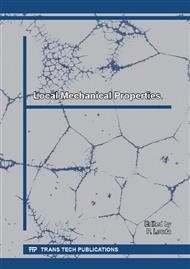p.3
p.7
p.11
p.15
p.20
p.25
p.29
p.33
p.37
The Possibilities of Evaluating the Yield Strength in the Heat Affected Zones of a Weld through Indentation
Abstract:
The research focuses on elastic-plastic behaviour of welded joints of materials which are commonly used in both constructional practice and the automotive industry. The examined welded joints are oriented to a common constructional S355 and a modern high-strength steel DOMEX 700MC.The main tool for the assessment of the elastic-plastic response was the methodology based on the instrumented penetration testing with the use of a cylindrical indenter. The indentation tool was applied into narrow zones of welded boundaries. These zones represent critical areas of welded constructions because of a changing structure and different mechanical properties than the basic material possesses. The indentation data were recalculated to the mechanical properties in shear with the help of Hencky ́s hypotheses about material behaviour. The correctness of the used methodology was verified by a tensile test. The aim of the work is to determine optimal methods for defining a yield strength and to find a hardening trend in the zones. The comparison of these steels revealed different changes due to the welding process. A substantial decrease of the yield strength of Domex700MC was observed, as a contrary to a stable, or partially increased, yield strength of the S355 steel. Structural analyses revealed a different material response of the evaluated steels, according to a different hardness in the heat affected zone.
Info:
Periodical:
Pages:
20-24
Citation:
Online since:
July 2016
Authors:
Price:
Сopyright:
© 2016 Trans Tech Publications Ltd. All Rights Reserved
Share:
Citation:


